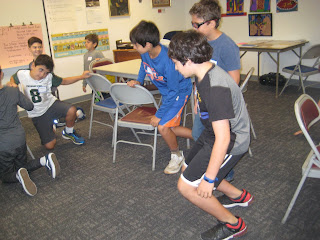Just before asking the above question, I reviewed the image that Talmudic era Rabbis created of a timeline on which we are all balancing as we follow the commandments and do good deeds, our role in partnering with God to create a just universe for all living things. After asking the question, I added, "Do we even know when we are losing our balance and falling?" To help answer this second question, I reminded the students of the Roadrunner cartoons we all watched, when Wiley E. Coyote is chasing the Roadrunner. They all recalled the images of Wiley Coyote following the Roadrunner off a cliff and continuing to run with no ground beneath him, until suddenly he would look down, realize he had just gone off a cliff and then fall crashing down to the ground. This is the image I wanted the students to have as we discussed whether we could always tell if we had "lost our balance."
As students began to share what they might have done to "lose their balance" during the previous year, a few shared that they may have unwittingly said something that hurt a friend's feelings or forgotten to do a chore their parents had asked them to do. Neither example was done on purpose, but everyone agreed that they "lost their balance" in those cases without realizing they had done so.
We then went back to my original question, with students sharing how they thought they could "get back on the timeline." At that point, I introduced the Hebrew word, "t'shuva" which literally means, turning around or returning. What are we "returning" to? To the timeline, to where we fell off so we can continue to "balance" on it.
1) You have to realize you did something wrong and determine exactly what it was you did;
2) You have to ask forgiveness from all the injured parties, including yourself (after all, it's you who "lost your balance"). Ideally, asking for forgiveness face-to-face is the best way, according to the Rabbis, but if it's not possible, then anyway you can is acceptable;
3) If possible, you have to try to immediately correct the situation that made you "lose your balance";
4) And finally, you have to make a plan of action that will help you avoid making the same mistake in the future.
 |
| Once these steps were discussed, I pointed out a wall poster I had made several years ago with the 4 steps of T'shuva written on it, so we could all remember them throughout the year. |
We also participated in a whole-school "T'shuva" activity:
 |
| Rabbi Greninger arranged to have 26 large pieces of paper hung on the walls in our upstairs hallway. Each page had a letter of the English alphabet printed on its top. |
 |
| Our students were asked to think of something they were sorry for which began with the particular letter on the page, and write it on that page. |
 |
| Our Edot students took this activity very seriously. |
Here are two examples of what they wrote:
Our Hebrew Through Movement session was a review of vocabulary introduced to date, including "leetko'a shofar" (blow a shofar), and introduced the Hebrew word "sleecha" (forgive me; I'm sorry). Of course, to have fun, we didn't only blow the shofar...
 |
| I didn't even think about the result when I commanded the boys, "La'seem shofar al ha'rosh shel Charlie." ("Put a shofar on Charlie's head.") |
Who ever said that learning Hebrew had to be boring?!!!
G'MAR CHATIMA TOVA. MAY YOU BE SEALED (IN THE BOOK OF LIFE).

















































